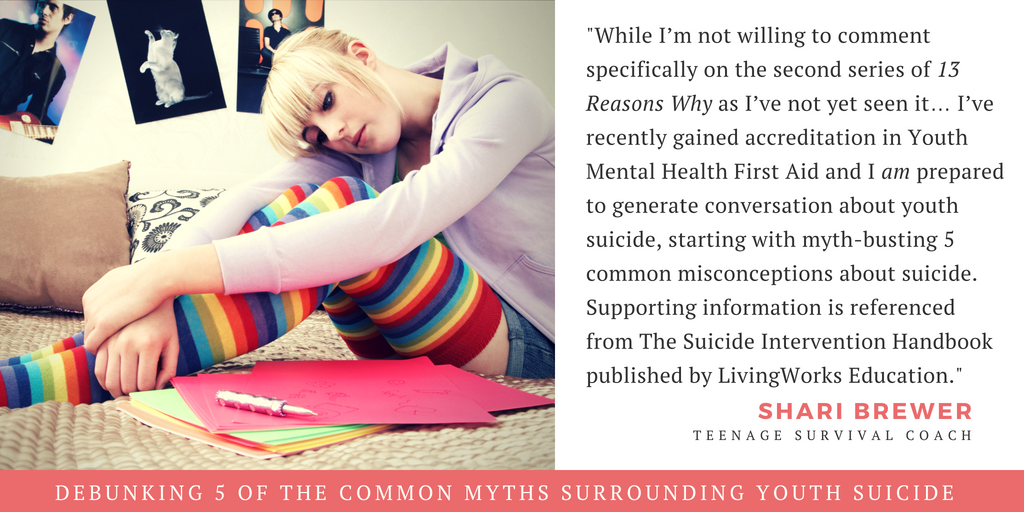13 Reasons Why – the Nextflix series airing in 2017 and focusing on the sensitive topic youth suicide – came under fire and created much controversy amidst graphic scenes and then fear of copy-cat behaviours. This year a second series has been released and is currently fuelling conversation along similar lines … what age group should be seeing this program if at all it’s suitable for viewing by young people? Should adolescent viewers require adult supervision while watching it? Does a TV series such as this glorify or promote violence, mental health conditions and youth suicide?
So many questions raised… and yet the reality of suicide (amongst youth or older populations) remains a huge, unsolved problem with no quick-fix or easy solution.
In short, and without yet viewing this second series of 13 Reasons Why, I firmly believe discussion around youth suicide requires matter-of-fact, yet sensitive, adult involvement. More so, I also firmly believe it’s a topic which must be raised, thoughtfully discussed and never tossed into a ‘too hard’ or ‘I don’t know how to talk about this’ basket. Conversation creates awareness, awareness can lessen shame and lives can possibly be saved.
While I’m not willing to comment specifically on the second series of 13 Reasons Why as I’ve not yet seen it… I’ve recently gained accreditation in Youth Mental Health First Aid and I am prepared to generate conversation about youth suicide, starting with myth-busting 5 common misconceptions about suicide. Supporting information is referenced from The Suicide Intervention Handbook published by LivingWorks Education.
MYTH 1 – Most youth suicides are caused by a single, sudden and traumatic incident
REALITY – A sudden and painful event may play a contributing factor in a young person’s decision to suicide but is unlikely to be the only cause. Usually a decision to die by suicide is made after a build up of numerous difficult events, feelings and/or circumstances. The ‘straw that broke the camel’s back’ rarely fully explains someone’s decision to suicide.
MYTH 2 – Most suicides occur with little to no warning
REALITY – The majority of young people considering suicide give some clues – sometimes these may be subtle changes in emotions, behavioural signs or can even be direct requests for help. Professionals cite a number of possible warning signs, though in isolation they may not be indicative of suicidal thoughts. If you ever have any concern about someone not seeming to be like their usual selves, please be sure to ask RUOK.
MYTH 3 – You shouldn’t talk about suicide with a young person who you think might be at risk.
Thoughtful, sensitive and serious conversation about suicide doesn’t create or increase the risk of someone attempting to take their own life. If anything, it can provide an opportunity to reduce potential risk. Open and direct talk about suicide demonstrates genuine concern and can be an prompt for someone at risk to engage in support. Avoiding the topic altogether can leave an at-risk teen feeling alone, ashamed and too anxious to seek help.
MYTH 4 – Young people are at much greater risk of suicide than other age groups
Sad truth is that all ages are at risk of suicide. We are hearing much more about youth suicide due to online/social media bullying being identified as a significant contributing factor to a number of recent tragic deaths. Statistically unemployed middle aged men, people with diagnosed personality disorders and those with chronic mental health issues are also highly at risk. There is no social, ethnic or age group immune to the risk of suicide.
MYTH 5 – Young people who talk about suicide won’t ever go through with it.
Research indicates that most people who attempt suicide have usually spoken (either directly or in a roundabout way) of their intentions beforehand. If a young person expresses suicidal thoughts do not assume they are attention-seeking. It’s important to take their conversation seriously and then following up with professional help is crucial.
If you are concerned for a young person (or someone any age) who you believe is considering suicide, then please seek professional assistance as soon as possible.
Assistance can be sought from:
- Local GP (if they do not have an immediate plan or means for attempting suicide)
- 000 or Hospital emergency department
- Lifeline 13 11 14
- Beyond Blue 1300 22 4636 or www.beyondblue.org.au
- Kids Helpline 1800 55 1800
- Headspace in your local metropolitan or regional area

